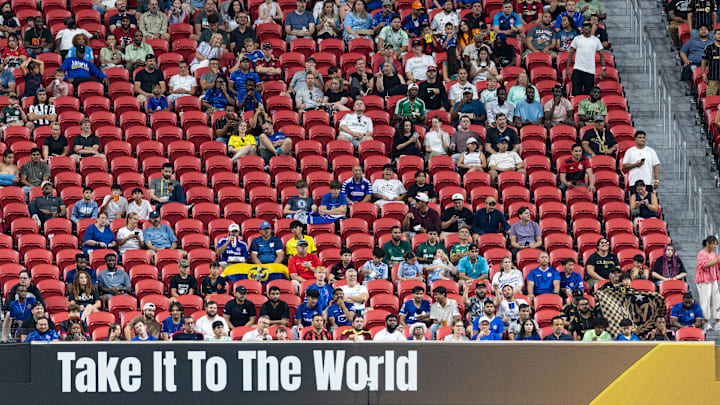When FIFA president Gianni Infantino decided to revamp the Club World Cup and bring it to the United States for the summer of 2025, he sold it as a momentous occasion, the introduction of another major competition to international soccer's increasingly busy calendar. Unfortunately, no one bothered to tell the fans.
The story of the Club World Cup to date has been as much who isn't there as who is — plenty of major clubs and players aren't participating, and so far at least, the public hasn't really either. Screenshots of empty stands have gone consistently viral on social media, and the numbers do seem pretty damning: 46,275 to watch Palmeiras and Porto at MetLife Stadium in New Jersey, a pitiful 22,137 to watch Chelsea and LAFC at Mercedes-Benz Stadium in Atlanta. (“The environment,” Chelsea coach Enzo Maresca said afterward, “was a bit strange.”)
All of which has created some uncomfortable optics for Infantino and Co., especially considering their ... let's just say "overheated" rhetoric in trying to sell the event in the months and weeks leading up to the opening ceremony. It's also created more than a little skepticism ahead of that other tournament coming to North America just 12 months from now: the 2026 World Cup, which will be jointly hosted by the U.S., Mexico and Canada. The degree to which American is, can ever or will ever be a soccer nation is already the subject of heated debate; if this was a trial run to see how fit they were to host the most important sporting event on Earth, early results are mixed at best.
But it should be obvious why it's a mistake to conflate yet another in an increasingly long line of summer cash grabs with the literal World Cup. And while this event appears to be falling fall short of expectations, it's worth asking just who set those expectations in the first place — and whether it has anything to do with what will happen enxt summer.
Club World Cup attendance is about the failures of the Club World Cup — and nothing else
The stage for failure was set from the beginning. The public has never really clamored for another club event to fill the summer gap between domestic seasons (just ask the International Champions Cup). And club teams, particularly the biggest ones in Europe, definitely weren't clamoring for it, considering just how much of a grind their campaigns have become in recent years.
Infantino's response to all of that was, basically, to fake it until he made it. The event would feature “the 32 best clubs and best players from all over the world,” Infantino said at the tournament draw last winter. “Two, three, four million fans will be coming to the U.S.; four, five billion will be watching from home.”
But no matter how hard FIFA and its paid influencers tried, and no matter how many tens of millions were spent on marketing, fans saw the Club World Cup for what it really was: a bloated cash grab. It would be one thing if expectations were more reasonable, and if this tournament was treated and priced like a developmental experiment to let fans see up-and-coming players and give clubs around the world a rare shot at slaying one of the giants of the sport. Instead, FIFA hiked up prices to impossible levels and made preposterous claims that were all-too-easy to tune out.
And this has been the result: half-empty football stadiums and hardly any media buzz for what looks and feels like (and is) just another set of summer exhibitions to kill time until the real seasons start. But while the CWC should rightly be considered a dud, any panic about what it means for next summer's World Cup is misplaced, to put it mildly.
There's no reason to be skeptical about World Cup attendance in 2026
The World Cup needs no introduction; it's the closest thing we have a sporting event that brings the entire globe together, watched by billions of people around the world. Stakes? They couldn't be higher? Ticket prices? As we've seen time and again, fans will pay just about anything to watch their country go for glory. It speaks for itself, and it's impossible to screw up — though lord knows FIFA has tried.
There's no reason to think that attendance at the Club World Cup means anything for 2026. If anything, the two might be inversely related; given the get-in prices for CWC games, it's reasonable to think that fans would want to keep their powder dry and save their big expense for next year, when they can watch the games that actually matter.
And there's also the simple fact that, for most even diehard American soccer fans, the novelty here has worn off. Most people simply haven't heard of, say, Espérance Tunis or Botafogo, and the ICC and events like it have made bigger club appearances in the States more and more commonplace in recent years. Hosting a World Cup, on the other hand, still feels bracingly new: If you're under the age of 30, odds are you don't even remember the last time the men's version of the event was played on American soil. And there's no sales pitch needed to get people to care, at least for a few weeks, about nationals teams leaving their hearts on the field.
